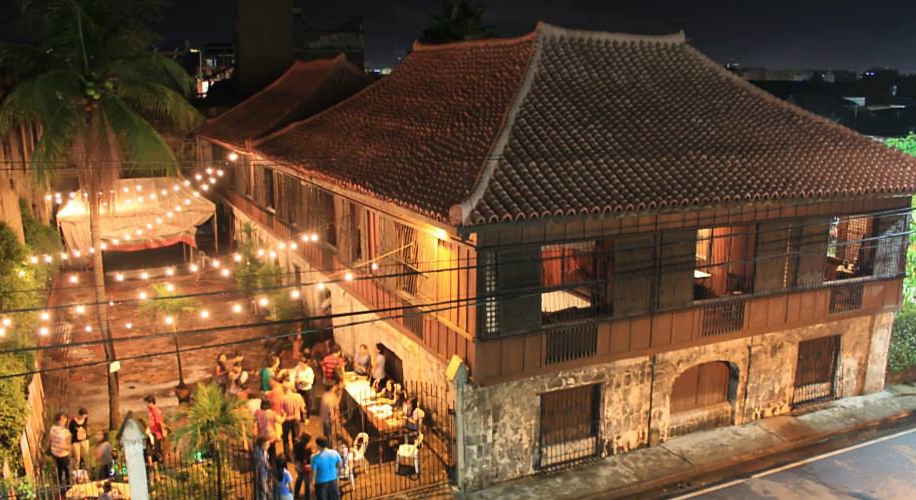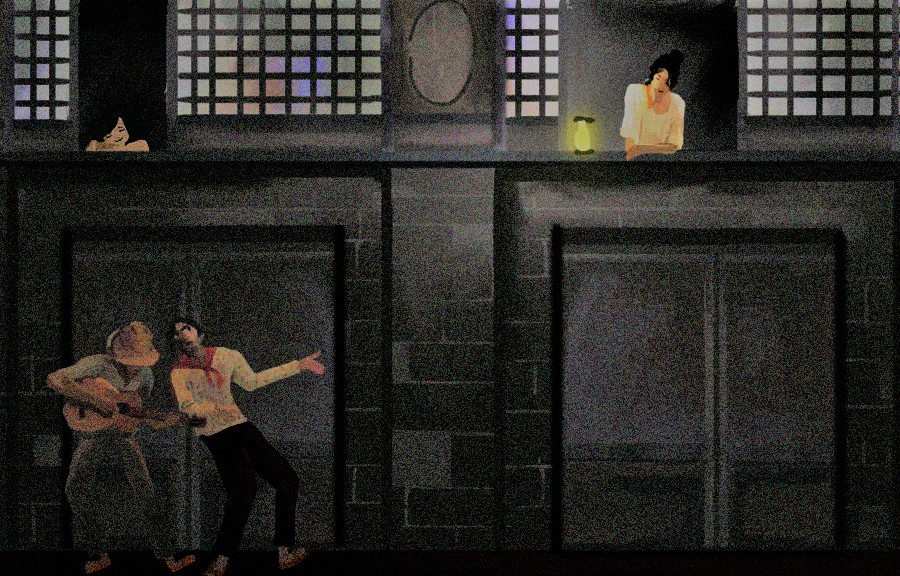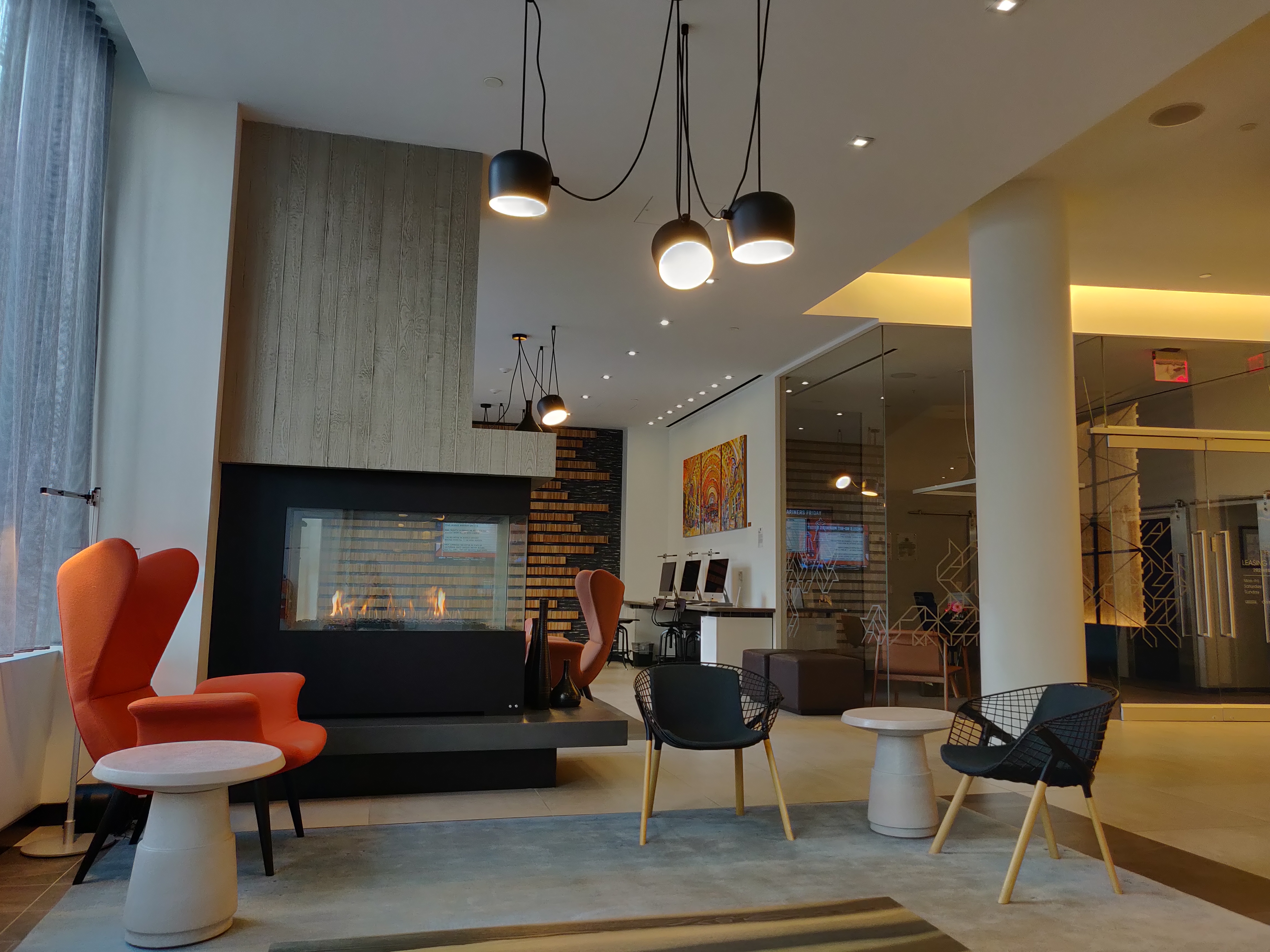|
Daku Balay
Daku Balay ("Big House") is the ancestral home of Don Generoso Villanueva, situated on Burgos Street, Bacolod, Philippines. The home of Generoso M. Villanueva, a prominent sugar planter, and his wife Paz took three years to build from 1933-1936. It was the first art deco structure to be built in Bacolod. Designed solely by the owner and built by Cebu engineer Salvador Cinco, the three-story, poured-concrete steel reinforced building with graceful curved balconies, parapets, and porthole steel-cased windows looks like the Titanic on land. It was known among the locals as the Boat House. Among family, though, it was simply called Daku Balay (the big house). One family story about Daku Balay was the family patriarch built it to fulfill a vow he had made to someday build the tallest house in the city so he could look down on the house of a business and political rival. The majestic rise of the 5,000-square-meter Daku Balay, with a five-level roof deck of over 600sm was ... [...More Info...] [...Related Items...] OR: [Wikipedia] [Google] [Baidu] |
Ancestral Home
An ancestral home is the place of origin of one's extended family, particularly the home owned and preserved by the same family for several generations. The term can refer to an individual house or estate, or to a broader geographic area such as a town, a region, or an entire country. An ancestral home may be a physical place, part of a series of places that one associates with state, nation or region. In the latter cases, the phrase ancestral homeland might be used. In particular, the concept of a diaspora requires the concept of an ancestral home from which the diaspora emanates. However, it is also possible that " e family living in an ancestral home is surrounded by visible, physical symbols of family continuity and solidarity". Ancestral homes and diaspora Ancestral homes are considered by some social scientists to be central to humans' need to acquire a sense of rootedness and smoothly transition to and from different stages of life. People maintain their connections to thei ... [...More Info...] [...Related Items...] OR: [Wikipedia] [Google] [Baidu] |
Negros Island
Negros is the fourth largest and third most populous island in the Philippines, with a total land area of . Negros is one of the many islands of the Visayas, in the central part of the country. The predominant inhabitants of the island region are mainly called '' Negrenses'' (locally ''Negrosanons''). As of 2020 census, the total population of Negros is 4,656,945 people. From May 29, 2015 to August 9, 2017, the whole island was governed as an administrative region officially named the Negros Island Region, which comprised the highly urbanized city of Bacolod and the provinces of Negros Occidental and Negros Oriental, along with its corresponding outlying islands and islets within a total regional area of . It was created on May 29, 2015 by virtue of ''Executive Order No. 183'' issued by Benigno Aquino III, who was the president at that time. On August 9, 2017, President Rodrigo Duterte signed the Executive Order No. 38 dissolving the Negros Island Region. History Precolonia ... [...More Info...] [...Related Items...] OR: [Wikipedia] [Google] [Baidu] |
World War II
World War II or the Second World War, often abbreviated as WWII or WW2, was a world war that lasted from 1939 to 1945. It involved the vast majority of the world's countries—including all of the great powers—forming two opposing military alliances: the Allies and the Axis powers. World War II was a total war that directly involved more than 100 million personnel from more than 30 countries. The major participants in the war threw their entire economic, industrial, and scientific capabilities behind the war effort, blurring the distinction between civilian and military resources. Aircraft played a major role in the conflict, enabling the strategic bombing of population centres and deploying the only two nuclear weapons ever used in war. World War II was by far the deadliest conflict in human history; it resulted in 70 to 85 million fatalities, mostly among civilians. Tens of millions died due to genocides (including the Holocaust), starvation, ma ... [...More Info...] [...Related Items...] OR: [Wikipedia] [Google] [Baidu] |
Harana (serenade)
The harana is a serenade tradition in rural areas of the Philippines in which young men may formally meet single lady visitors.Proceedings of the 2nd Conference on History and Culture 1993 - Page 12 "Harana" is the Filipino term tor serenade. But unlike in Europe, harana in the Philippines is generally a formal way of getting to meet lady visitors in rural Philippines. ln harana, the songs that are usually sung are dansas like "0 llaw", "Maala-ala ..." Form Traditionally, the suitor or ''manliligaw'' will visit the house of the girl he is trying to woo, and sing by her window until she comes out to either accept or deny him. The suitor may or may not be accompanied, but usually his companions will be playing a guitar or provide back up vocals as he sings. Ideally, the ''dalaga'' or young lass will choose to accept him. History The harana first gained popularity in the early part of the Spanish period. Its influence comes from folk Music of Spain and the mariachi sounds of Mex ... [...More Info...] [...Related Items...] OR: [Wikipedia] [Google] [Baidu] |
Cornucopia
In classical antiquity, the cornucopia (), from Latin ''cornu'' (horn) and ''copia'' (abundance), also called the horn of plenty, was a symbol of abundance and nourishment, commonly a large horn-shaped container overflowing with produce, flowers, or nuts. Baskets or panniers of this form were traditionally used in western Asia and Europe to hold and carry newly harvested food products. The horn-shaped basket would be worn on the back or slung around the torso, leaving the harvester's hands free for picking. In Greek/Roman mythology Mythology offers multiple explanations of the origin of the cornucopia. One of the best-known involves the birth and nurturance of the infant Zeus, who had to be hidden from his devouring father Cronus. In a cave on Mount Ida on the island of Crete, baby Zeus was cared for and protected by a number of divine attendants, including the goat Amaltheia ("Nourishing Goddess"), who fed him with her milk. The suckling future king of the gods had unusual ... [...More Info...] [...Related Items...] OR: [Wikipedia] [Google] [Baidu] |
Carabao
The carabao ( es, Carabao; tgl, Kalabaw; ceb, Kabaw; ilo, Nuang) is a domestic swamp-type water buffalo (''Bubalus bubalis'') native to the Philippines. Carabaos were introduced to Guam from the Spanish Philippines in the 17th century. They have acquired great cultural significance to the Chamorro people and are considered the unofficial national animal of Guam. In Malaysia, carabaos (known as kerbau in Malay) are the official animal of the state of Negeri Sembilan. Etymology The Spanish word is derived from Visayan (likely Waray) . Cognates include Cebuano , Javanese , Malay , and Indonesian Dutch . The female is called (in Spanish) a . The word's resemblance to ''caribou'' is coincidental, and they do not share a common etymology — an example of a false cognate. Carabaos are also known in Tagalog as (derived from Spanish). Before the Spanish era, carabaos were more widely known as ''nuang'' among the Ilocanos of Northern Luzon, and ''anowang'' and ''damulag'' among ... [...More Info...] [...Related Items...] OR: [Wikipedia] [Google] [Baidu] |
Relief
Relief is a sculptural method in which the sculpted pieces are bonded to a solid background of the same material. The term ''relief'' is from the Latin verb ''relevo'', to raise. To create a sculpture in relief is to give the impression that the sculpted material has been raised above the background plane. When a relief is carved into a flat surface of stone (relief sculpture) or wood (relief carving), the field is actually lowered, leaving the unsculpted areas seeming higher. The approach requires a lot of chiselling away of the background, which takes a long time. On the other hand, a relief saves forming the rear of a subject, and is less fragile and more securely fixed than a sculpture in the round, especially one of a standing figure where the ankles are a potential weak point, particularly in stone. In other materials such as metal, clay, plaster stucco, ceramics or papier-mâché the form can be simply added to or raised up from the background. Monumental bronze reliefs a ... [...More Info...] [...Related Items...] OR: [Wikipedia] [Google] [Baidu] |
Cruise Ship
Cruise ships are large passenger ships used mainly for vacationing. Unlike ocean liners, which are used for transport, cruise ships typically embark on round-trip voyages to various ports-of-call, where passengers may go on tours known as "shore excursions". On "cruises to nowhere" or "nowhere voyages", cruise ships make two- to three-night round trips without visiting any ports of call.Compare: Modern cruise ships tend to have less hull strength, speed, and agility compared to ocean liners. However, they have added amenities to cater to water tourists, with recent vessels being described as "balcony-laden floating condominiums". As of December 2018, there were 314 cruise ships operating worldwide, with a combined capacity of 537,000 passengers. Cruising has become a major part of the tourism industry, with an estimated market of $29.4 billion per year, and over 19 million passengers carried worldwide annually . The industry's rapid growth saw nine or more newl ... [...More Info...] [...Related Items...] OR: [Wikipedia] [Google] [Baidu] |
Molave Tree
''Vitex parviflora'' is a species of plant in the family Verbenaceae, also known as smallflower chastetree or the molave tree. The name "molave" is from Spanish, derived from ''mulawin'', the Tagalog word for the tree. It is also known as ''tugas'' in Visayan languages. It yields one of two woods from the same genus called molave wood, the other being ''Vitex cofassus''. It is a native species in Indonesia, Malaysia, and the Philippines. It can also be found in Central and South America, the Caribbean, Oceania, and Asia. It was reported to be an invasive species in Guam and Hawaii after it became naturalized in O’ahu and escaped from cultivation in Guam. In Cuba, it is also considered as a possibly invasive species due to naturalization. It is valued in the Philippines for its dense durable wood and was once used extensively in furniture, boats, utensils, and as construction material. The wood is also known to resist decay and termites. It became a protected species in the ... [...More Info...] [...Related Items...] OR: [Wikipedia] [Google] [Baidu] |
Hardwood
Hardwood is wood from dicot trees. These are usually found in broad-leaved temperate and tropical forests. In temperate and boreal latitudes they are mostly deciduous, but in tropics and subtropics mostly evergreen. Hardwood (which comes from angiosperm trees) contrasts with softwood (which is from gymnosperm trees). Characteristics Hardwoods are produced by angiosperm trees that reproduce by flowers, and have broad leaves. Many species are deciduous. Those of temperate regions lose their leaves every autumn as temperatures fall and are dormant in the winter, but those of tropical regions may shed their leaves in response to seasonal or sporadic periods of drought. Hardwood from deciduous species, such as oak, normally shows annual growth rings, but these may be absent in some tropical hardwoods. Hardwoods have a more complex structure than softwoods and are often much slower growing as a result. The dominant feature separating "hardwoods" from softwoods is the presence o ... [...More Info...] [...Related Items...] OR: [Wikipedia] [Google] [Baidu] |
Lobby (room)
A lobby is a room in a building used for entry from the outside. Sometimes referred to as a foyer, reception area or an entrance hall, it is often a large room or complex of rooms (in a theatre, opera house, concert hall, showroom, cinema, etc.) adjacent to the auditorium. It may be a repose area for spectators, especially used before performance and during intermissions, but also as a place of celebrations or festivities after performance. Since the mid-1980s, there has been a growing trend to think of lobbies as more than just ways to get from the door to the elevator but instead as social spaces and places of commerce. Some research has even been done to develop scales to measure lobby atmosphere to improve hotel lobby design. Many office buildings, hotels and skyscrapers go to great lengths to decorate their lobbies to create the right impression and convey an image. [...More Info...] [...Related Items...] OR: [Wikipedia] [Google] [Baidu] |

.jpg)


.jpg)

